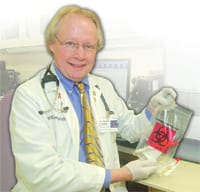Progress Report Why Hospital-acquired Infections Are on the Decline
When Dr. Robert Hoffman was in training during the ’70s, hospital-acquired infections such as pneumonia and line septis, which occurs when an intravenous line becomes infected, were so common, it was assumed they could not be avoided.
“At that time, we couldn’t imagine that these hospital-acquired infections would go away. Yet today, they are considered unacceptable and are rarely seen,” said the chairman of Infection Control and chief of Infectious Diseases at Mercy Medical Center in Springfield, Noble Hospital in Westfield, and Healthsouth Rehabilitation Hospital of Western Mass. in Ludlow.
Indeed, dramatic inroads in infection prevention have been made over the past decade, and today, medical care centers have zero tolerance for hospital-acquired infections. They have formed teams to prevent them, which keep pace with best practices and investigate why they occur so they can eliminate their cause. This is critical, since surgery, chemotherapy, and the use of invasive devices and procedures — coupled with illness and powerful antibiotics which eradicate good bacteria along with bad — create an environment in hospitals where infections could easily thrive and spread.
“It is always a problem,” Hoffman said. “Being hospitalized is a cost-benefit tradeoff, but in the end, the ultimate benefit is greater than the risk.”
Still, in spite of zero-tolerance policies, hospitals have not been able to eradicate all health care-acquired infections. “But if a patient does develop one, we do a root-cause analysis to see what could have been done differently,” said Mary Ellen Scales, director of Infection Control at Baystate Medical Center. “The whole concept is getting to a zero rate, so we look at what we need to do to provide more education and support to patients because they can help with things such as letting their nurse know if they think they have a fever, and not touching their dressings.”
For this issue, the Healthcare News looks at the types of measures hospitals across Western Mass. have employed to protect patients and halt the spread of hospital-acquired infections.
Proactive Approach
Cooley Dickinson Hospital in Northampton has taken a proactive stance in this matter. Infectious disease and wound care provider Dr. William Swiggard said CDH adopted a collaborative approach that goes beyond the concept of teamwork by soliciting ideas from every hospital employee, including those who do the laundry, clean the rooms, and write grants.
“In 2008, we organized 27 separate small teams that were drawn from many parts of the hospital and represent everything we do,” he said, adding that CDH takes more medically complex cases than the average community hospital.
One important change it has made is to test emergency-room patients for methicillin-resistant staphylococcus aureus infection (MRSA) before they are admitted. “We are the only hospital in the Pioneer Valley that does this,” said Swiggard, adding that the test involves swabbing the inside of the nostrils where MRSA populations tend to colonize.
Although in most cases, MRSA bacteria are harmlessly attached to the skin, when they are introduced to a place that is normally sterile like the bloodstream or urinary bladder, they can cause an aggressive infection. “When people develop such aggressive infections, they are treatable, but the list of antibiotics that is effective is much shorter than with other infections,” Swiggard explained. He added that chronic diseases such as diabetes, recent treatment with antibiotics, and/or having been recently hospitalized or in a nursing home where there are crowded conditions raise the risk of infection.
In the past, if a patient tested positive, he had to wait to be admitted until a private room became available. But last spring, Cooley Dickinson speeded up its admission process by making every room in the medical-surgical portion of the hospital private.
When a patient does test positive for MRSA, gowns and gloves must be worn by anyone entering their room. Hospital staff members also take great care when they move things from one room to another and when they are cleaning and disinfecting the rooms to avoid possible spread of the staph infection. “As a result, we haven’t had a death from MRSA in two years,” Swiggard said.
In 2006, the hospital participated in a pilot program to reduce MRSA in its artificial joint center, which won it a number of awards. “We are the only hospital in the Pioneer Valley that Blue Cross Blue Shield rated as a Blue Distinction Center for Knee and Hip Replacement,” he said.
CDH patients are screened for MRSA a week before surgery and go through a special decontamination procedure before entering. “It’s really important, because a hip prosthesis can’t heal if it gets infected. If that happens, we have to remove it, which is one of the things we are trying to prevent,” Swiggard said, adding that since they began the screening four years ago they haven’t had a single infected prosthesis.
The hospital is also vigilant about preventing ventilator-associated pneumonia, which is usually serious and caused by bacteria, which can be resistant to antibiotics. “We were one of only three hospitals in the state to institute a program across multiple disciplines, which was developed in 2008 by the CDC and the Institute for Health Care Improvement. It dramatically reduced the number of ventilator-associated pneumonia cases,” said Swiggard.
The goal of another new measure is to reduce chlostridium difficile, commonly referred to as C-dif, which causes acute diarrhea and occurs mostly in people treated with strong antibiotics. In addition to following guidelines about the use of antibiotics, Cooley Dickinson administers probiotics or ’beneficial bacteria’ to patients taking antibiotics.
“Antibiotics kill 95{06cf2b9696b159f874511d23dbc893eb1ac83014175ed30550cfff22781411e5} of good bacteria in the colon, which gives the remaining 5{06cf2b9696b159f874511d23dbc893eb1ac83014175ed30550cfff22781411e5} that are resistant to the drugs the opportunity to take over,” Swiggard said. “Probiotics are harmless, but occupy the sites the harmful bacteria would stick to.”
These methods, in conjunction with others, such bringing in special ultraviolet lights to sanitize rooms, are a result of the hospital’s interdisciplinary efforts to prevent infection.
Employing Best Practices
In 2002, Baystate was chosen to represent the state in a national program to reduce surgical site infections, which is the same year the CDC changed its guidelines regarding hand hygiene.
Scales said the CDC deemed alcohol hand rubs more effective than soap and water, so dispensers were installed throughout its hospitals. Since that time, health care workers have been continuously reminded to be vigilant about using them. “Many new guidelines and interventions were also put into place at that time to prevent infections, and the results have been dramatic,” he explained.
Patient education is something the hospital takes seriously, and to that end Baystate created a bedside patient and visitor guidebook. “It is our goal to partner with our patients to get them back to their previous state of health,” Scales said, adding that the information inside the booklets changes each year.
Tips include asking visitors to refrain from touching supplies used to care for patients, asking them to stay home if they are sick, and reminding patients to wash their hands not only before they eat, but after using the bathroom or a bedpan, or touching something soiled. If they cannot get up to wash their hands, they are advised to ask caregivers for help. The booklet also instructs them to let nurses know if their intravenous or surgical dressing is wet, loose, or has fallen off, and remind people caring for them to sanitize their hands. “As health care gets more and more technical, we get very busy and appreciate the reminders,” Scales said.
The hospital also keeps abreast of best practices in infection prevention, which are shared with all of its health care providers. These include cleaning and disinfecting the site of intravenous lines before and after they are put in. “Some cancer patients have them for months and refer to them as their lifeline, so caring for them and teaching patients how to do this properly is critical,” Scales said.
Other infection-prevention measures involve using special dressings and procedures for gastrointestinal devices that insure maximum sterility. Attention is also paid to mechanical ventilation and ensuring that people on ventilators have the heads of their beds elevated to help prevent pneumonia.
Baystate also makes a point of removing ventilators and other invasive devices as quickly as possible. “Invasive devices and procedures can raise the risk of infection if best practices are not employed,” Scales said. “And the longer a device is in, the more likely it is that the patient will have some type of complication.”
Baystate has a simulation lab as well as a simulated operating room with sophisticated, life-like mannequins that allow nurses and doctors to practice procedures such as correctly inserting a central intravenous line, providing yet another defense against health care-associated infections.
Decided Teamwork
Mercy Medical Center has its own dedicated program to combat infection. “We strive for a zero infection rate and come very close to that in areas we never imagined possible,” said Hoffman, adding that infections such as hospital-acquired pneumonia or bacteremia, which occurs when bacteria enters the bloodstream, are extremely rare.
In addition to Hoffman, the hospital employs two full-time infection-control nurses who constantly check to make sure best practices are followed by every employee.
“For example, when patients need to be isolated, we make sure it is done right, that the door to the room is kept closed and the right equipment is available for people entering it,” Hoffman said.
If and when a hospital-acquired infection does occur, “we set up an action plan to do something about it. We find out why it happened and what we can do to prevent it from happening again,” he continued. “We make a great effort to identify problems that might have gone unnoticed in another era. We make sure techniques to prevent infection continue to be emphasized, and any aberrations are investigated to find out what went wrong.” Staff also constantly analyze data and search for new products such as bladder catheters or intravenous equipment less likely to cause infection.
Mercy’s infection-control team has four formal meetings each year, but also meets informally on a frequent basis. It is composed of doctors and nurses along with representatives from a number of departments, including the Pharmacy, the Microbiology Lab, and the Occupational Health Department. “These people all have information that we need, and we trade ideas,” Hoffman explained.
Hospital administrators are present at meetings, which is extremely important, as they have to be convinced to spend health care dollars on measures the team deems necessary. “If it makes sense and we can explain what we need clearly, they find a way to do it,” he said.
These measures, combined with the Internet, which allows health care providers across the world to share information, have made an enormous difference in preventing the spread of hospital-acquired infections.
“In the end,” Hoffman said, “it’s better to know what the infections are and be able to fix them rather than not understand them and let them fester the way they did a generation ago.”



